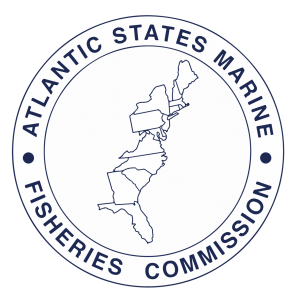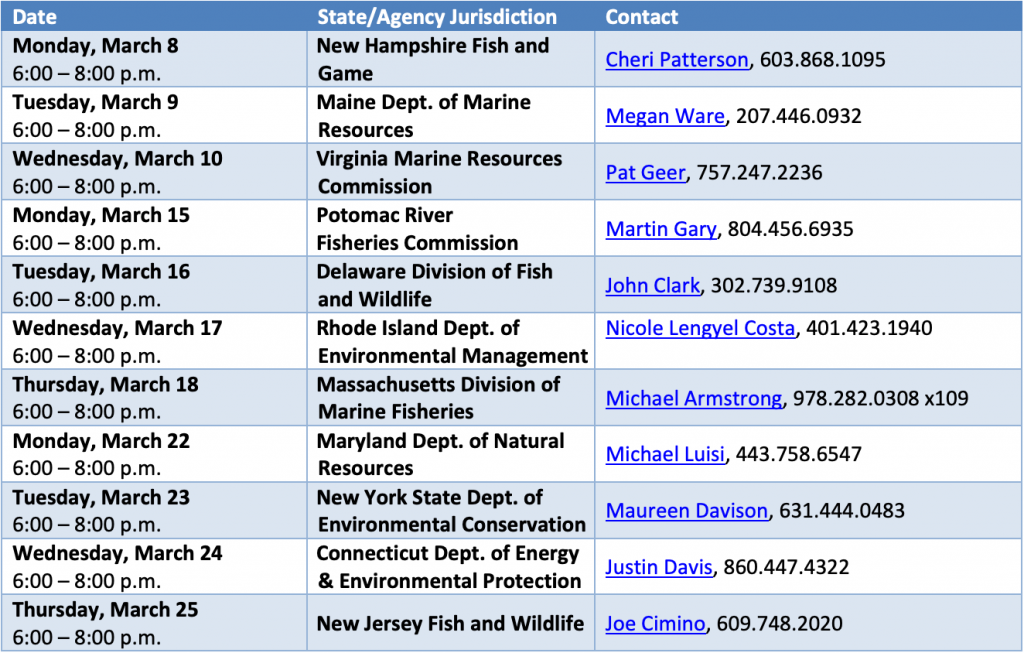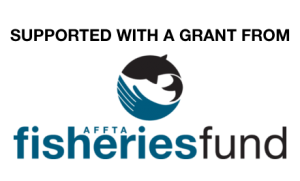ACTION ALERT- ASMFC Draft Amendment 7 PID (Public Information Document)

ACTION ALERT
ASMFC Draft Amendment 7 PID (Public Information Document)
The Atlantic States Marine Fisheries Commission (ASMFC) has produced a Public Information Document (PID) requesting comments and input from interested parties regarding the Striped Bass fishery. “This is your opportunity to inform the Commission about changes observed in the fishery, actions you feel should or should not be taken in terms of management, regulation, enforcement, and research, and any other concerns you have about the resource or the fishery, as well as the reasons for your concerns.” -ASMFC
The full PID can be found here: Draft Amendment 7 Public Information Document (PID) Public Comment Feb. 2021
The audio/video Public Hearing Presentation can be found here: https://www.youtube.com/watch?v=DdHHIifU7DI&feature=youtu.be
Registration for live hearings (all states) can be found here: https://register.gotowebinar.com/rt/8168283291056270608
Stripers Forever has studied the PID and have formulated responses to each of their areas of concern. Our comments are numbered 1 through 10, corresponding to the numbered document. What follows is a summary of our official positions on each area.
IMPORTANT NOTE: When reading these SF position statements, please compare them to your own thoughts and then, in your email to the ASMFC, formulate your own comments IN YOUR OWN WORDS. We strongly suspect that all comments received by the ASMFC that use the same language/wording get lumped together and end up counting as only one point of view from one source. Make your comments your own in order to make them count. They can be as brief or lengthy as you wish.
The items included in the PID are: 1. Fishery Goals and Objectives 2. Biological Reference Points 3. Management Triggers 4. Stock Rebuilding Targets and Schedule 5. Regional Management 6. Management Program Equivalency (Conservation Equivalency) 7. Recreational Release Mortality 8. Recreational Accountability 9. Coastal Commercial Allocation 10. Any other issues concerning the management of Atlantic striped bass.
Note that the current management regime under Amendment 6 was adopted in 2003, and failed in its objective to rebuild stocks.
Please refer to the PID for specific language on each of the following issues.
Issue 1: Goal (“To perpetuate… migratory stocks of striped bass.”) is fine.
- Objective 4 (“Foster quality and economically viable recreational, for-hire, and commercial fisheries.”): remove the commercial reference. Recreational anglers are the overwhelmingly dominant user both in terms of numbers of participants and economic impact. Managing for commercial interests runs counter to the greater public good.
- Objective 6 (“Adopt a long-term management regime that minimizes or eliminates the need to make annual changes or modifications to management measures.”): Gamefish status would solve this.
Issue 2: SF’s position is to maintain existing biological reference points (BRPs) since we know that the stock can attain those levels as it has in the past.
Issues 3 & 4: Management triggers & timeline (“Up to ten years.”): Keep what is there and follow what they say should happen. Triggers were ignored after implementation in Amendment 6 and that is at least part of why the stocks are where they are today after 18 years of a ten-year plan. For Issue 4, SF’s position is to rebuild the stocks, and maintain, sustain abundance, vs. manage for “maximum sustainable yield.”
Issue 5: Regional Management is a good idea. Chesapeake Bay is the Striped Bass’ primary nursery and should be managed differently than the coastal fishery should be different. In addition we are strongly recommending the adoption of seasonal closures in spawning locations such as the Hudson River. Striped Bass should be given the opportunity to spawn without human intervention. Closing the Hudson River, Ny Bight and Raritan Bay to Striped Bass Fishing in the spring would protect large females as they migrate from spawning grounds into their coastwide distribution. This is a no brainer and we believe it will dramatically protect and improve the spawning stock biomass. It won’t be easy though, unless you have game fish status.
Issue 6: Conservation Equivalency should be status quo, but with consequences when states adopt CE measures that fail to achieve desired outcomes.
Issue 7: Recreational Release Mortality: The circle hook requirement is fine as implemented in Addendum VI. Treble hook use on artificial lures, and proper handling should be a continuing education process.
Issue 8: Recreational Accountability: Implementing recreational harvest limits (RHLs) will be a problem until the Marine Recreational Information Program (MRIP) is supplying timely and high confidence data.
Issue 9: Coastal Commercial Quota Allocation; The simplest answer is to make it a game fish. End of story. Harvesting juvenile fish in Chesapeake Bay and larger, breeder-size females along the coast runs counter to achieving management goals.
Issue 10: Other issues: “How would you like management of the Atlantic striped bass fishery to look in the future?” Stripers Forever stands by its mission: Make it a Game Fish.
Stripers Forever remains committed to fighting for Striped Bass designation as a game fish, protected from commercial harvest. That is beyond the ASMFC’s charter, and so the following recommendations reflect what we believe to be steps that are both reasonable and aggressive, carving the surest path to rebuilding healthy, abundant Striped Bass stocks, based on the goals of the ASMFC as stated in the PID for adoption of Amendment 7.
- Moratorium (coast and bay, no recreational or commercial harvest) of 10 years’ duration to ensure the success of the ASMFC’s 10-year stock rebuilding plan.
- No targeting Striped Bass in traditional spawning areas, as determined by local authorities.
- Issue a $25 Striped Bass stamp to fund and support collection of timely, high-confidence MRIP data.
- Ban the commercial gillnet fishery (Coast and Bay); adopt hook-and-line fishing only where commercial harvest persists.
- Include a metric to account for commercial release discard mortality (including bycatch and poaching) to ensure accurate commercial impact and accountability.
- Stronger punishments for poaching (counting black market catch against commercial quota, lifetime ban from all commercial and recreational fisheries for multiple or egregious offenders, gear forfeiture, larger fines, etc.).
- Limit treble hooks to one per artificial lure.
- Require barbs on artificial lures be flattened when used for striped bass.
You have an opportunity to influence the overall management of our Striped Bass right now. We all need to join forces and submit comments to the ASMFC that state loudly and clearly that the health of the Atlantic Striped Bass stock – not harvest – should be the highest priority of Amendment 7. Stripers Forever has a singular mission to put the fish first – let’s all do our part to communicate this same message to the ASMFC and to your state’s ASMFC reps to the Atlantic Striped Bass Management Plan.
For full information and a schedule of state-by-state public hearings on the Atlantic Striped Bass Draft Amendment 7 PID in March – please see the ASMFC’s NEWS RELEASE.
Registration for live hearings below can be found here: https://register.gotowebinar.com/rt/8168283291056270608

Public comments are being accepted through 5pm, April 9, 2021 and can be emailed to comments@asmfc.org (Subject line: Striped Bass PID). Also consider sending comments directly to your state’s commissioners to the Atlantic Striped Bass Management Plan.
Please also copy your state’s delegation on any comments to the ASMFC. Here is link to state board and advisory commission members.
Thank you!
ADDITIONAL LINKS
- Atlantic Striped Bass Board- February 3, 2021 Meeting Audio/Video (YouTube)
- Atlantic Striped Bass Board- February 3, 2021 Meeting (Collected Slides PDF- No Audio)
- Atlantic Striped Bass Board- Main Meeting Materials
- Atlantic Striped Bass Board- Supplemental Meeting Materials 1
- Atlantic Striped Bass Board- Supplemental Meeting Materials 2
- Atlantic Striped Bass Board- PID Public Comment News Release
- Atlantic Striped Bass Board- Draft Amendment 7 Public Information Document (PID) Public Comment Feb. 2021







